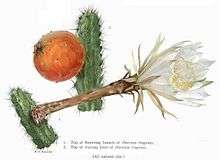Harrisia fragrans
Harrisia fragrans (syn. Cereus eriophorus var. fragrans) is a rare species of cactus known by the common names fragrant prickly apple and Caribbean applecactus. It is endemic to Florida, where it is known mainly from St. Lucie County. The plant's habitat has been almost completely consumed by development, leading to its rarity. It is a federally listed endangered species of the United States.
| Harrisia fragrans | |
|---|---|
 | |
| Scientific classification | |
| Kingdom: | Plantae |
| Clade: | Tracheophytes |
| Clade: | Angiosperms |
| Clade: | Eudicots |
| Order: | Caryophyllales |
| Family: | Cactaceae |
| Subfamily: | Cactoideae |
| Genus: | Harrisia |
| Species: | H. fragrans |
| Binomial name | |
| Harrisia fragrans | |
Description
This is an erect or spreading cactus with narrow, long stems which can well exceed one meter in length, at times approaching five meters.[1][2] It is covered in long, yellow or yellow-tipped spines which may be up to 4 centimeters long.[2] It produces enormous tubular flowers up to 20 centimeters long which are sweet-scented and white to pinkish in color.[2] They bloom at night. The fruit is spherical and red or orange in color, measuring up to 6 centimeters wide. The fruits are a favorite food of local birds,[2] which likely help to disperse the seeds.[3] The cactus has been noted to live at least 19 years, and in general has low fecundity; older, larger plants are more likely to survive, and they have higher fecundity, as well.[3] Small plants may benefit from growing with nurse plants.[4]
Habitat
The plant's favored natural habitat is mostly coastal hammocks with some shade, as the cactus can become desiccated in full sun.[3] Coastal hammocks of this kind have become uncommon as they have been cleared for development and heavily fragmented.[3]
There are ten confirmed occurrences of the plant, nine of which occur around Savannahs Preserve State Park in St. Lucie County and totalled 2150 individuals in the year 2002.[3] The tenth confirmed occurrence is at the Canaveral National Seashore in Volusia County, and it contains about 96 plants.[3] An occurrence has been reported in Indian River County, but it has not been confirmed.[3] The cactus once grew in at least two places in Brevard County, but these populations have been extirpated.[3]
Threats
Remaining populations of the cactus can now be found in sandy scrub habitat.[3] The remaining habitat is degraded with the overgrowth of invasive plant species such as love vine (Cassytha filiformis).[3] While the cactus does not like full sun, it also cannot tolerate being shaded out by brush.[3] Other threats to the plant have been all-terrain vehicles, herbicides, feral pigs, and hurricane damage from wind and falling branches.[3] Populations have been vandalized with machetes.[3] Cacti have died from being buried in sand, and have been stolen by cactus enthusiasts and collectors.[3] A scale insect, Diaspis echinocacti, sometimes eats the stems of the cactus, and some sort of caterpillar has been noted to inflict some damage.[3] Woodpeckers have been observed poking holes in the stems, which injures the plants.[4] Most of the remaining populations are within the bounds of a state park, so their habitat is safe from development.[3]
References
- "Comprehensive Report Species - Harrisia fragrans". NatureServe. The Nature Conservancy. August 2010. Retrieved 31 January 2011.
- "Harrisia fragrans in Flora of North America @ efloras.org". Flora of North America. Retrieved 31 January 2011.
- USFWS. Harrisia fragrans Five Year Review. June 24, 2010.
- Possley, Jennifer (March 2010). "National Collection of Imperiled Plants - Plant Profiles". Center for Plant Conservation, Missouri Botanical Garden, St. Louis, Missouri. Archived from the original on 2010-12-15. Retrieved 31 January 2011.
